#Regression analysis
Explore tagged Tumblr posts
Text
What Are the Regression Analysis Techniques in Data Science?
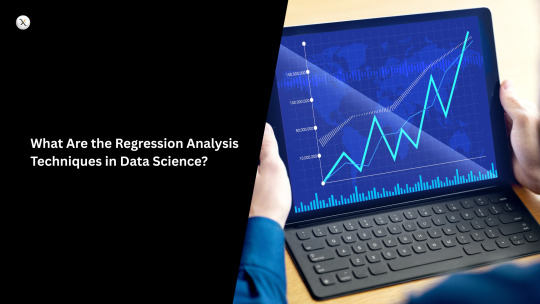
In the dynamic world of data science, predicting continuous outcomes is a core task. Whether you're forecasting house prices, predicting sales figures, or estimating a patient's recovery time, regression analysis is your go-to statistical superpower. Far from being a single technique, regression analysis encompasses a diverse family of algorithms, each suited to different data characteristics and problem complexities.
Let's dive into some of the most common and powerful regression analysis techniques that every data scientist should have in their toolkit.
1. Linear Regression: The Foundation
What it is: The simplest and most widely used regression technique. Linear regression assumes a linear relationship between the independent variables (features) and the dependent variable (the target you want to predict). It tries to fit a straight line (or hyperplane in higher dimensions) that best describes this relationship, minimizing the sum of squared differences between observed and predicted values.
When to use it: When you suspect a clear linear relationship between your variables. It's often a good starting point for any regression problem due to its simplicity and interpretability.
Example: Predicting a student's exam score based on the number of hours they studied.
2. Polynomial Regression: Beyond the Straight Line
What it is: An extension of linear regression that allows for non-linear relationships. Instead of fitting a straight line, polynomial regression fits a curve to the data by including polynomial terms (e.g., x2, x3) of the independent variables in the model.
When to use it: When the relationship between your variables is clearly curved.
Example: Modeling the trajectory of a projectile or the growth rate of a population over time.
3. Logistic Regression: Don't Let the Name Fool You!
What it is: Despite its name, Logistic Regression is primarily used for classification problems, not continuous prediction. However, it's often discussed alongside regression because it predicts the probability of a binary (or sometimes multi-class) outcome. It uses a sigmoid function to map any real-valued input to a probability between 0 and 1.
When to use it: When your dependent variable is categorical (e.g., predicting whether a customer will churn (Yes/No), if an email is spam or not).
Example: Predicting whether a loan application will be approved or denied.
4. Ridge Regression (L2 Regularization): Taming Multicollinearity
What it is: A regularization technique used to prevent overfitting and handle multicollinearity (when independent variables are highly correlated). Ridge regression adds a penalty term (proportional to the square of the magnitude of the coefficients) to the cost function, which shrinks the coefficients towards zero, but never exactly to zero.
When to use it: When you have a large number of correlated features or when your model is prone to overfitting.
Example: Predicting housing prices with many highly correlated features like living area, number of rooms, and number of bathrooms.
5. Lasso Regression (L1 Regularization): Feature Selection Powerhouse
What it is: Similar to Ridge Regression, Lasso (Least Absolute Shrinkage and Selection Operator) also adds a penalty term to the cost function, but this time it's proportional to the absolute value of the coefficients. A key advantage of Lasso is its ability to perform feature selection by driving some coefficients exactly to zero, effectively removing those features from the model.
When to use it: When you have a high-dimensional dataset and want to identify the most important features, or to create a more parsimonious (simpler) model.
Example: Predicting patient recovery time from a vast array of medical measurements, identifying the most influential factors.
6. Elastic Net Regression: The Best of Both Worlds
What it is: Elastic Net combines the penalties of both Ridge and Lasso regression. It's particularly useful when you have groups of highly correlated features, where Lasso might arbitrarily select only one from the group. Elastic Net will tend to select all features within such groups.
When to use it: When dealing with datasets that have high dimensionality and multicollinearity, offering a balance between shrinkage and feature selection.
Example: Genomics data analysis, where many genes might be correlated.
7. Support Vector Regression (SVR): Handling Complex Relationships
What it is: An adaptation of Support Vector Machines (SVMs) for regression problems. Instead of finding a hyperplane that separates classes, SVR finds a hyperplane that has the maximum number of data points within a certain margin (epsilon-tube), minimizing the error between the predicted and actual values.
When to use it: When dealing with non-linear, high-dimensional data, and you're looking for robust predictions even with outliers.
Example: Predicting stock prices or time series forecasting.
8. Decision Tree Regression: Interpretable Branching
What it is: A non-parametric method that splits the data into branches based on feature values, forming a tree-like structure. At each "leaf" of the tree, a prediction is made, which is typically the average of the target values for the data points in that leaf.
When to use it: When you need a model that is easy to interpret and visualize. It can capture non-linear relationships and interactions between features.
Example: Predicting customer satisfaction scores based on multiple survey responses.
9. Ensemble Methods: The Power of Collaboration
Ensemble methods combine multiple individual models to produce a more robust and accurate prediction. For regression, the most popular ensemble techniques are:
Random Forest Regression: Builds multiple decision trees on different subsets of the data and averages their predictions. This reduces overfitting and improves generalization.
Gradient Boosting Regression (e.g., XGBoost, LightGBM, CatBoost): Sequentially builds trees, where each new tree tries to correct the errors of the previous ones. These are highly powerful and often achieve state-of-the-art performance.
When to use them: When you need high accuracy and are willing to sacrifice some interpretability. They are excellent for complex, high-dimensional datasets.
Example: Predicting highly fluctuating real estate values or complex financial market trends.
Choosing the Right Technique
The "best" regression technique isn't universal; it depends heavily on:
Nature of the data: Is it linear or non-linear? Are there outliers? Is there multicollinearity?
Number of features: High dimensionality might favor regularization or ensemble methods.
Interpretability requirements: Do you need to explain how the model arrives at a prediction?
Computational resources: Some complex models require more processing power.
Performance metrics: What defines a "good" prediction for your specific problem (e.g., R-squared, Mean Squared Error, Mean Absolute Error)?
By understanding the strengths and weaknesses of each regression analysis technique, data scientists can strategically choose the most appropriate tool to unlock valuable insights and build powerful predictive models. The world of data is vast, and with these techniques, you're well-equipped to navigate its complexities and make data-driven decisions.
0 notes
Text
Mars Crater Study-2
This article was written as a practice exercise with reference to the information provided in the COURSERA course, specifically the Mars Crater Study.
=========================================
In this analysis, we used data on Martian craters to explore the impact of crater diameter, latitude, and longitude on their depth through multiple regression analysis. Our model shows that these variables significantly affect the variation in crater depth, with an overall R-squared of 0.345, indicating that the model explains about 34.5% of the variation in depth.
Relationship Between Explanatory Variables and Response Variable
1. Crater Diameter (DIAM_CIRCLE_IMAGE)
Beta Coefficient: 0.0151
p-value: 0.000
Relationship: Significantly positive, indicating that for each unit increase in crater diameter, the depth increases by an average of 0.0151 units.
2. Latitude (LATITUDE_CIRCLE_IMAGE)
Beta Coefficient: -6.507e-05
p-value: 0.000
Relationship: Significantly negative, suggesting that for each unit increase in latitude, the depth decreases by an average of 6.507e-05 units.
3. Longitude (LONGITUDE_CIRCLE_IMAGE)
Beta Coefficient: 3.384e-05
p-value: 0.000
Relationship: Significantly positive, indicating that for each unit increase in longitude, the depth increases by an average of 3.384e-05 units.
Hypothesis Testing
Our results support the initial hypothesis that crater diameter has a significant positive impact on crater depth. This indicates that larger craters tend to have greater depths. Additionally, geographical location (latitude and longitude) also has a significant effect on depth.
Confounding Factors Analysis
After incrementally adding latitude and longitude as control variables, we found no significant confounding effect on the relationship between diameter and depth. This means that while geographical location affects depth, it does not significantly alter the relationship between diameter and depth.
Regression Diagnostic Plots
a) Q-Q Plot
The Q-Q plot shows the normality of the residuals. The skewness of the residuals indicates some deviation from normal distribution, which may require further model adjustments.

b) Standardized Residuals Plot
The standardized residuals plot helps identify outliers and the model's fit. Some points deviate from the center line, indicating that the model may not fit well for certain observations.

c) Leverage Plot
The leverage plot shows influential observations and potential outliers. There are several points with high leverage values, which may have a significant impact on the model's fit.

Conclusion
In conclusion, our multiple regression analysis provides valuable insights into the factors influencing crater depth. Future research could further explore other potential variables and adjust the model to improve fit and explanatory power.
0 notes
Text
IBM SPSS ile Çoklu Regresyon Modeli Oluşturma
Regresyon analizi, bağımlı değişken ile bağımsız değişkenler arasındaki ilişkileri ölçmek ve tahmin etmek için kullanılan bir istatistiksel yöntemdir. Bu analiz, özellikle iki veya daha fazla nicel değişken arasındaki ilişkileri anlamak için tercih edilir ve doğrusal ya da doğrusal olmayan modellerle gerçekleştirilebilir. Regresyon analizi, birçok farklı alanda kullanılabilen güçlü bir…
#aysemece#Ayşem Ece#Ayşem Ece Yalçınkaya#Çoklu regresyon analizi#data analysis#Eğitim ve Seminerler#IBM SPSS#regression#Regression analysis#Regresyon analizi#SPSS#SPSS ile regresyon
0 notes
Text
Research Made Simple: Regression Analysis
Research Made Simple: Regression Analysis #FOANed #nursing #nursingresearch #regressionanalysis #research
Undertaking research is difficult, especially the statistical analysis part if your main role is clinial focused and research is just one aspect of your role. There is a difference between a research nurse and a nurse researcher. These Research Made Simple posts aim to help provide introductory or refresher resources for nurses undertaking clinical research projects. What is regression analysis…

View On WordPress
0 notes
Link
1 note
·
View note
Text
Essentials of Data Analysis

Data Analysis is an integral part of every business.There are various data analysis technique which can be applied with all kinds of data in order to find patterns, discover insights and making data-driven decisions. The following gives a brief idea of the process and the techniques undertaken during data analysis:
Process followed in Data Analysis
Define your goals clearly
Collect the required data
Data Cleaning by removing unnecessary rows and columns and redundant data
Analyze data using various tools
Visualizing Data
Drawing an inference and conclusion
Methods of Data Analysis (for both Quantitative and Qualitative Data)
Sentimental Analysis
Regression Analysis
Time Series Analysis
Cluster Analysis
Predictive Analysis
Check out our master program in Data Science and ASP.NET- Complete Beginner to Advanced course and boost your confidence and knowledge.
URL: www.edujournal.com
#Sentimental Analysis#Regression Analysis#Time Series Analysis#Cluster Analysis#Predictive Analysis#inference#Visualizing Data#Analyze data#Data Cleaning#Data_Collection
1 note
·
View note
Text
1 note
·
View note
Text
Daryl Dixon took awhile to age mentally
As I read more and more analysis about Daryl and rewatch some of the earlier seasons, I wonder if it was intended for his character to have some kind of age regression issue. (I didn't do, like, extensive research, I just looked into some CPTSD and age regression signs on a few different sites, so this is just an idea I'm tossing out in hopes of hearing some other perspectives!)
The first situation that really catches my attention is his reaction to Merle being left in Atlanta. Now, obviously, this would be an incredibly emotional time for anyone and it's not entirely out of place to just say he was very distraught over the news and anyone could have reacted the same way he did. I just think that the specific way he did might have some signs. If you think about a grown man, especially one who was raised in a very macho household, you would assume that their reaction might be to storm out or yell at someone. Although Daryl did yell, he also started crying and pacing. It seemed almost as if he was having a full-on meltdown. Some signs of age regression are meltdowns (Ranting, shouting, insulting others, threatening others, whining, angry tears, or getting physically violent) that ring any bells?
I couldn't find a gifs of that exact moment :(
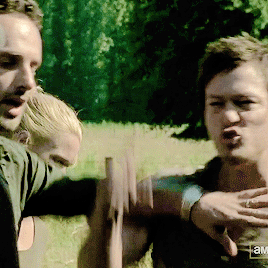
It probably didn't help that the entirety of the camp was staring at him as all of this happened. Temper tantrums can happen because someone is scared/ashamed and can't regulate themselves. (Like sensory overload.)
Another thing that I want to kind of address is the way Rick responds to Daryl when he's having these sorts of meltdowns. Throughout the series, and in the third episode, we see Rick bending down almost horizontally just so he can make eye contact with Daryl. He speaks to him like he's a child, and instead of feeling insulted, Daryl actually takes comfort in it and calms down!
"I'd like to have a calm discussion on this topic, do you think we can manage that?"
What is age regression?
We all know that Daryl was abused as a child, and trauma like that can sort of freeze the brain. This is a quote I really like that explains it: “It doesn’t necessarily make you stuck at a certain age, but instead, [you are] acting out the emotional wounding that happened at that age,” Lapides adds." People may start to regress because they are triggered or feel threatened, and an apocalypse seems like it would cause a constant trigger. Daryl might be reverting back to childlike behaviors as a trauma response. (honorable mention being the nail biting, but that's a bit of a reach) Shane being the way that he was could have also been a trigger for him.
One of the symptoms of age regression is overly clingy behavior. And you are probably thinking, "well, if there's anything Daryl has, it's not clingy behavior. He's a loner." I disregarded this too for awhile before I really thought about it. He is highly independent when he's doing things he's comfortable in, like being in the woods or going for runs. But when it comes to making decisions or being social, Daryl immediately clings to someone who he knows will do it for him. Most of his life he had Mere to hide behind. The most outgoing and shameless person alive. I don't think Merle ever asked Daryl his opinion on anything. He would decide, and Daryl would follow, and I think Daryl took a lot of comfort in that. So when Merle was gone, he latched onto Rick because he was the best choice. He knew Rick was a very righteous man who had plenty of leadership qualities. He knew Rick would make decisions for him, and give him directions.
Carol and Rick's mothering
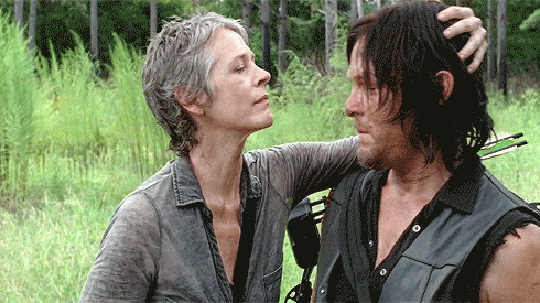
Circling back to the way Rick would react to Daryl's outbursts, carol sometimes did the same thing. I know some people ship them, but honestly, at least in the earlier seaons, I got major mother/son vibes from the two of them. Especially when Beth died and she was trying to teach him how to grieve. The forehead kisses, the pookie nickname, all of it seemed to point in that direction. There was also another time Rick pulled the "Can we manage that?" move, and it was during Aiden and Glenn's fight in S5. He made sure to get low enough to make eye contact, and block his pacing. He kept telling Daryl that "We can't do this now." It all just looks a lot like he and carol are parenting Daryl, if only in moments where he is feeling intense stress and that trauma triggers.
Anyways, this was just a few ideas I was tossing around, and very clearly this in my first analysis lol, any thoughts?
#twd#age regression#character analysis#fictional characters#daryl dixon#twd daryl#the walking dead#carol peletier#rick grimes#shane walsh#childhood abuse#trauma response#trauma regressor
280 notes
·
View notes
Text
with all of the cradle and lullaby theming in Wiege, Luka being portrayed as childish and drawn looking a little bit younger, the back and forth flashes of him when he was a child vs him as an adult, and him practically waddling over to Hyuna like an excited child — and this isn’t even mentioning his tendencies to drool (that could be a product of an illness though) and to suck / chew on things — I am about 100% sure that Luka is an age regressor
#alnst agere#alien stage agere#fandom agere#sfw agere#sfw age regression#alien stage#alnst#luka alien stage#alnst luka#alien stage analysis
60 notes
·
View notes
Text
Totally off topic but I'm listening to random Kpop as I work and it's a bunch of like new release 4th and 5th gen shizz and then Block B's NalinA comes on and I'm like.
LEGAND
How are they still so damn good? Just blows everything else out of the water.
youtube
#block b#nalina#look they just hit different#i'll return you to your regularly scheduled BL nonsenses#as soon as this effing regression analysis is done#kpop#3rd gen hits different#will die on this hill#Youtube
27 notes
·
View notes
Text
When you try to kill your enemies only to realize that you have been fighting your team the entire time:
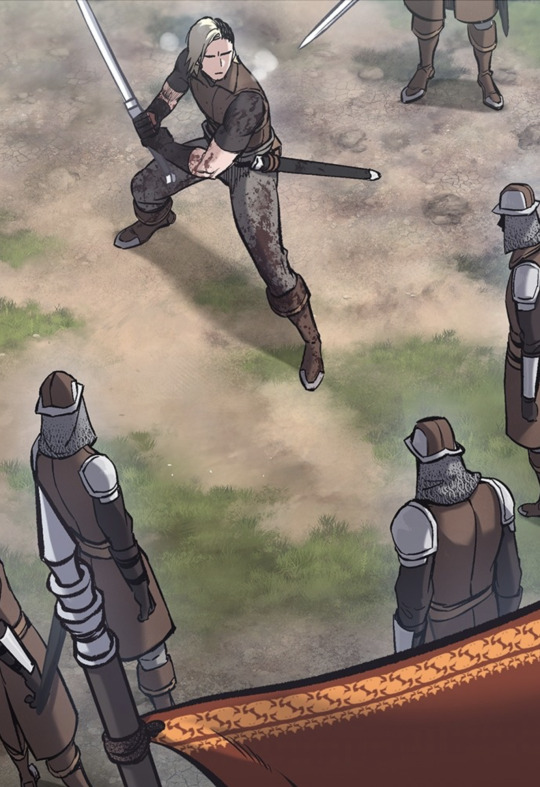
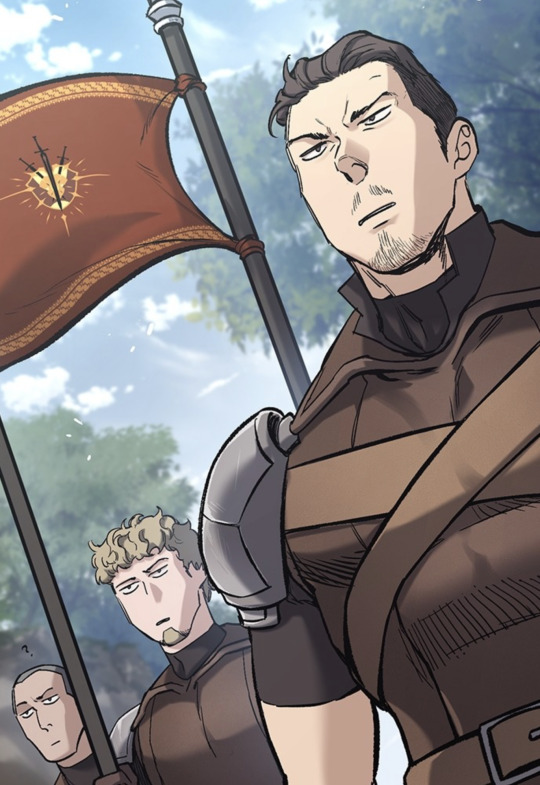
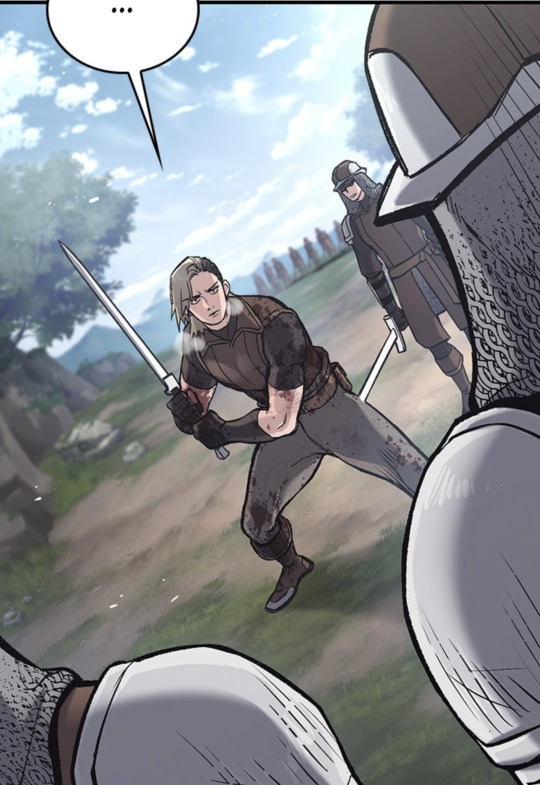
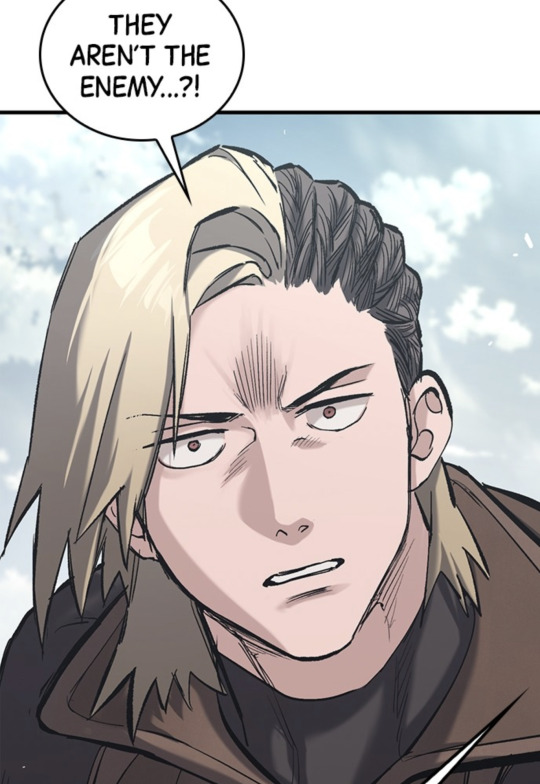
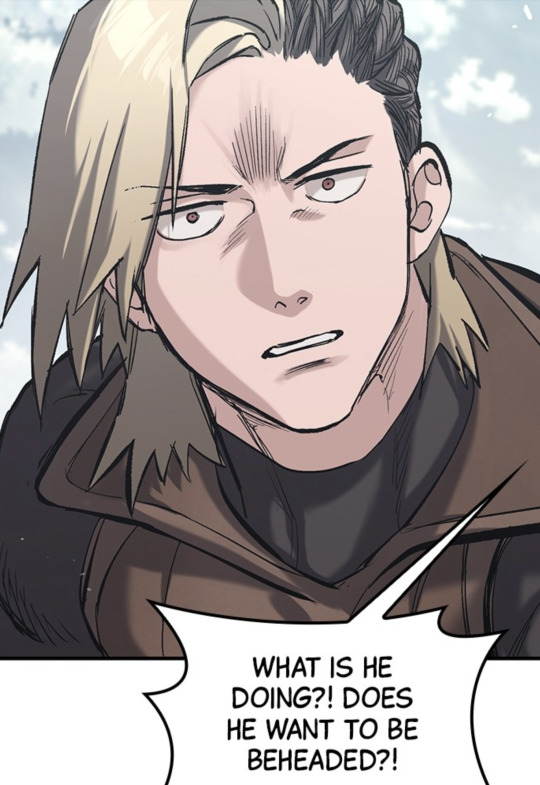
Man. Ragna's expression is really funny in this scene!
#eternally regressing knight#webtoon#manhwa#regression manhwa#funny memes#regression#a knight who eternally regresses#the knight only lives today#action#action manhwa#adaptation#adventure#adventure manhwa#fantasy#fantasy manhwa#ragna#wrong target#oh shit#oh no#manhwa review#manhwa analysis#manhwa recommendation#webtoon recommendation#recommendation
20 notes
·
View notes
Text
Untitled Thought
Here they go again.
Anxiety arguing inside my heart.
How do I sweat them out of my heart is such a frozen state?
How do I sooth their souls when mine is so tangled?
...
I thought it would feel nice to enjoy a bit of normalcy before the commotion.
But it's too late. Been too late for a while...
All these moments to myself and in my head and on the floor and wet from tears-
Today I am strong.
I feel it deep in me, immersing into my soul.
Strength...
I used to run from her in fear of the things she would do to me; the things she would say in my head.
The person I would turn into.
Who I would leave behind-
Jaded into Peace.
I didn't recognize myself, and I still can't...
Who is that looking at me through my forehead?
Peering at the skin like a mirror and smiling through me...
Why can't I stop looking back?
What is this warmth I feel-
I felt so much that I froze in my thoughts.
And now I feel my right shoulder becoming warm. But I cannot see. Which I hate to admit...frightens me.
Am I thawing out or freezing into silence?
#brain vomit poetry#brain vomit#feelings#emotions#rootwork#poetic#love#self analysis#community#Lets talk about feelings#lets talk about it#im regressing
87 notes
·
View notes
Text
the poetics of sp's involvement in 1863rd is just ... there's no words to capture the how retrospectively tragic it is. sp is the oldest being in the story. his tragedy has stopped being told but the story was still continuing off the page, years and years and even more unending years of being trapped without resolution, blocked behind the wall. he wants to die but cannot.
hsy's plan was to make 1863 yjh sleep forever. while it is not true death obviously, it will have been the closest to death any yjh has ever gotten (besides 0th who still turned away from it). not death, not regression, but sleep. it is only the domain of the dreams that will let him escape the cruel reality of his unreality and the silent god who will continue to watch over him forever so long as it was this man, yjh.
an important recurring symbol/motif in orv is dreams and there are several important themes linked to dreams i want to discuss.
first one is pretty obvious: dreams as escapism, as a way to desperately wish for a better life, wanting desperately to be saved from a ruined world. ala 1863rd yjh's wish for death and the oldest dream's wish for the characters to become real, to save him. as such, dreams represent a desperate plea for salvation.
and this might be a reach but i would still like to argue that it is the character's belief of their own hopelessness that lead to dreams but also perpetuates an unending cycle. wanting to be saved but also not being able to believe that you're worthy of being saved, that nothing / no one would / should save you. this duality is what leads me to the second theme: in their endless cycle being trapped and neither dead nor living, dreams are but another form of regression.
kdj becomes the oldest dream, the willing lonely god who could only ever dream of everyone's happiness but his own. he had seperated himself from ever reaching out and watching 1864th worldline where all his loved ones are and where he knows he would have been tempted to return. so symbolically, he interferes with 0th yjh and, as his stardusts falls away, he watches all the regressions and yjh. always yjh. his dream. in the end, the train that traps him is himself.
but a final point i want to touch on is this:
it is only when they get off the train and reach their epilogue, does sp finally achieve liberation, does the oldest dream finally end (become free). the dream has ended and into the waking cruel world, they become characters no longer having found each other at last. this was sp's ■■. and that's what i meant by the poetics of it all. the happiest, gentlest of epilogues: the ending of the oldest dream.
#spod#joongdok#orv spoiler#orv analysis#long post#shit#fuck#this wasnt supposed to that long#i just wanted to talk about how sp and od's tragedy are both directly related to how they are equally trapped in a cycle#and how their happy ending is finding each other#and how beautiful it is that breaking the dream / regression / cycle isnt death or revenge#its the end of a dream#because the dream came true#and that is sp's true liberation
171 notes
·
View notes
Text
So I just won a competition for my research project…
MOM DAD IM A REAL SCIENTIST!!
#pretty crazy but yeah#we were doing a country wide data analysis on breast cancer incidence rates and ambient air pollution#multiple linear regression and what not#I wrote a manuscript and everything it was so cool!#now we present at nationals and have 0 chance of winning#but wtv#the process was more than satisfying!#studyblr#not studyspo#stem academia
55 notes
·
View notes
Text
Piltover is known as the City of Progress and in season one there is no one better to be the face of Piltover than Jayce Talis. Jayce Talis is as ambition as his desire to help people. He believes and achieves the impossible, his innovations completely change Piltover's global standing, and he constantly is pushing the boundaries with Hextech, even when it's unsafe and unwise to do so. Not only is he a symbol of Progress for technology, he's also a symbol of progress in politics. The council make an eighth seat of their government to make him a councilor, something that is unheard of in Piltover's history, and within days of being newly appointed he gets down to work and starts making big changes. Where all the other councilors are too busy arguing in sessions and putting their own needs first, Jayce Talis is making shit happen that directly impact the people, because to him being a councilor is about helping his constituents. He's also the first and only PERSON to manage to break a peace deal between Piltover and Zaun, a deal that would gain Zaun its independence, a deal he manages to get the council to AGREE TO!
But in season two, Jayce isn't the face of Piltover anymore. Caitlyn Kiramman becomes the new face of Piltover, but she isn't a symbol of progress- she's a symbol of regression. Piltover had always oppressed the city of Zaun, but during s1 Arcane they had entered an era where they left Zaun to themselves so long as Zaun didn't do anything that directly impacted Piltover. But under Caitlyn's leadership Piltover becomes the aggressor in the Piltover/Zaun relationship, just as they were years ago during the era of Silco and Zander and The Day of Ash. Caitlyn tears the undercity upside down, sets up borders and checkpoints. She sends so many zaunites to jail that Stillwater, which was once a secluded permission meant for only "the most vile of criminals" is now equipped with newly built transportation that carts off dozens of zaunites just in one trip. Zaunites wo haven't commited crimes too, I may add. She's almost single handedly raised tensions between the cities and has sparked a new wave of Piltover resentment in Zaunites. She doesn't even manage to make progress in the Jinx case either. She spends months terrorizing citizens in search for Jinx only for the most wanted terrorist to elude her.
Additionally, think about where we see Jayce and Caitlyn as symbols. In season one Jayce's face is plastered everywhere in Piltover, and nowhere in Zaun. This is because Jayce is only seen as a symbol for progress in Piltover. All the advancements he makes are advancements the Undercity never get to have access to in season one. By contrast, we only ever see Caitlyn's face in the Undercity while she's being seen as a symbol. This is because her actions don't impact the people of Piltover at all. They're not the ones getting gassed or having their homes unlawfully searched, they're in their cozy, lovely, "safe" city while the big, strong, Commander Kiramman delivers the "bad guy" to justice. Meanwhile in zaun, the people have to live everyday with the consequences of Caitlyn's unchecked grief as she tightens the noose around all of them little by little.
#this is NOT a 'jayce good...caitlyn bad...' post#this is a 'as leaders...jayce represents progression where caitlyn represents regression' post#mic does analysis#arcane season 2#arcane s2#arcane season two#arcane#jayce talis#caitlyn kiramman
12 notes
·
View notes
Text
We got some comments from the VAs of Liko, Roy and Dot about the upcoming chapter, Mega Voltage (translation here).
Liko's VA comments on Liko's current state of mind.
Roy's VA comments on the fact that Liko, Roy and Dot will set out to restore the truth about the Rising Volt Tacklers with Uruto.
Dot's VA mentions that the characters have grown and wonders what Dot has been up to (potentially hinting that we'll learn what she was doing during the year after Rakua).
Additionally, we got the first promotional pictures of the one-hour special that will air on April 11, as well as an illustration by Mojacookie.
#hz interview#chapter notes#mega voltage#really liked the way minori suzuki phrased things#liko being at a standstill. the wording is important!#she hasn't 'regressed'. she's been affected by past events and taking time to figure out what to do. taking the longer road etc#the fact she mentions that all of liko's past experiences are valuable and meaningful#even if she is at standstill now. she hasn't lost those things. nothing she did or experienced is meaningless#terasaki yuka's insight is always so interesting too.. she put my thoughts into words#how the kids started their journeys under the protection of adults (the first year of horizons)#how terastal debut helped them become more independent (the second year of horizons)#and now they're going to make their progress and decisions on their own and without the adults (third year of horizons)#the progress on this aspect is so well done. it's gradual and feels natural.#terasaki yuka's analysis is so good.. and fits my own ww#also it's sweet how roy's va talks about lucario being a special pkmn to her. she is definitely thinking of her time as corni in xy#dot's va mentioning that she is still in shock over how rayquaza rising ended. me too... me too#always like reading the VAs comments.. they always phrase things so succinctly and think a lot about the story.#the illustration by mojacookie is so cute too. i miss the rvt already#liko#roy#dot
10 notes
·
View notes